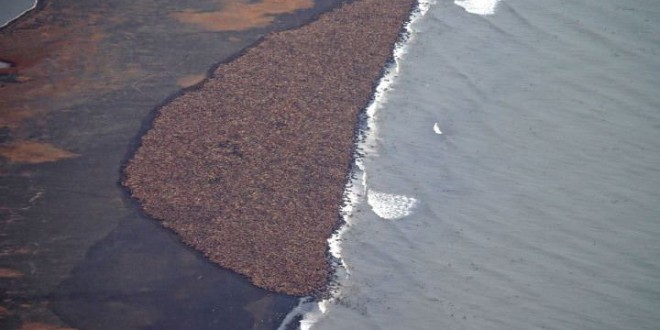An estimated 35,000 pacific walrus have been spotted ashore on a beach in north-west Alaska.
Unlike seals, the mammals cannot swim indefinitely and are now coming ashore in record numbers as they struggle to find sea ice for resting in the Artic.
The gathering of walrus on shore is a phenomenon that has accompanied the loss of summer sea ice as the climate has warmed. The extreme retreat of Alaska’s summer sea ice has led large numbers of Pacific walrus to haul out – leave the water for sites on land – instead of resting on offshore ice.
Walrus in large numbers were first spotted on the U.S. side of the Chukchi Sea in 2007. They returned in 2009, and in 2011, scientists estimated 30,000 walrus along a one-kilometer stretch of beach. Last year, a NOAA survey counted about 10,000 walrus on the beach near Point Lay.
Female Pacific walrus and their calves traditionally spend summers far from shore, diving for benthic invertebrates over the shallow continental shelf waters of the Chukchi Sea. The walrus prefer to rest between forage bouts on sea ice drifting above their feeding grounds. It’s the loss of summer sea ice over the continental shelf in recent years that has forced many walrus to travel to the northwest coast of Alaska where they haul-out on shore to rest.
Agencies/Canadajournal
 Canada Journal – News of the World Articles and videos to bring you the biggest Canadian news stories from across the country every day
Canada Journal – News of the World Articles and videos to bring you the biggest Canadian news stories from across the country every day



